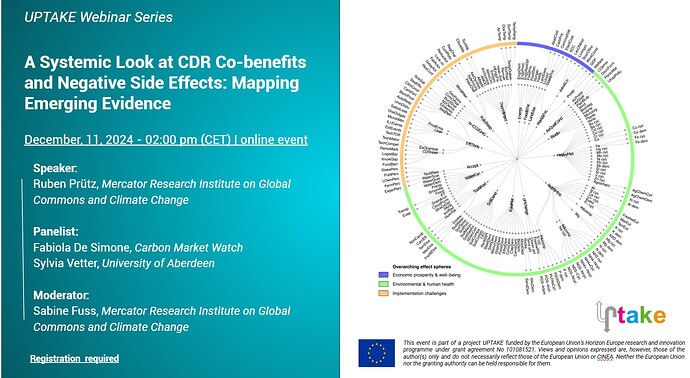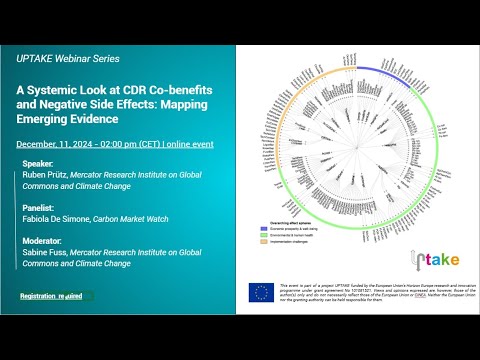A Systemic Look at CDR Co-benefits and Negative Side Effects: Mapping Emerging Evidence
Speaker:
Ruben Prütz, Mercator Research Institute on Global Commons and Climate Change (MCC)
Panelist:
Fabiola De Simone, Carbon Market Watch
Sylvia Vetter, University of Aberdeen
Moderator:
Sabine Fuss, Mercator Research Institute on Global Commons and Climate Change (MCC)
Key Insights:
-
The presented study provides an inventory and taxonomy of almost 400 co-benefits, challenges, and limits for six land-based carbon dioxide removal (CDR) options based on literature evidence.
-
The mapping of the literature shows relatively comprehensive evidence in Europe but little research on side effects across Africa and South America, even though large-scale land-based carbon removals are expected to occur in these regions in many scenarios.
-
Magnitude and desirability of identified side effects are strongly context-dependent and vary depending on the mode of implementation, location, and time.
The use of land-based CDR for climate change mitigation will come along with an array of environmental, socio-political, and economic implications – many of which have not yet been sufficiently understood, e.g., in the context of impacts on the natural cycling of nutrients and minerals or distributional consequences. While large-scale CDR will likely evoke undesired side effects, scientific evidence shows that side effects are highly context-dependent and vary depending on many factors, including the mode of implementation, deployment scale, and location. Research also shows the potential for co-benefits of CDR if carefully and sustainably implemented, e.g., enhancing wildlife by restoring degraded forests. The growth in research on CDR and potential side effects helps us to understand better how removals can be part of the solution while avoiding conflict with other policy goals such as sustainable development and eradicating poverty. However, when evidence is scattered and growing rapidly, it can become challenging to keep a good overview, especially when different strands of evidence seem contradictory at times.* As part of UPTAKE, we contributed addressing *this issue by systematically mapping the recent peer-reviewed scientific literature evidence on co-benefits, challenges, and limits for six land-based CDR options, namely afforestation and reforestation, bioenergy with carbon capture and storage, biochar, direct air capture with carbon capture and storage, enhanced weathering, and soil carbon sequestration.
The UPTAKE Webinar “A Systemic Look at CDR Co-benefits and Negative Side Effects: Mapping Emerging Evidence” on December 11th, first featured Ruben Prütz of the Mercator Research Institute on Global Commons and Climate Change (MCC Berlin) presenting the UPTAKE paper “A taxonomy to map evidence on the co-benefits, challenges, and limits of carbon dioxide removal” that was published in April this year in Communications Earth & Environment. Dr. Sylvia Vetter - an expert in modeling GHG emissions from agriculture, grasslands and land use change, impacts on soil and possible mitigation options of the University of Aberdeen - provided a deeper dive into land-based CDR options in particular, and commented on the gaps in the research landscape Ruben had introduced, remarking as well on the need for deployment to learn more about side effects. Fabiola de Simone is Carbon Market Watch’s policy expert on carbon removal then brought in the policy perspective, giving the audience a deeper look into what is needed at the science policy interface to contain undesirable side effects while exploiting synergies wherever possible. In particular, she argued for a supply-driven approach to CDR and provided some concrete ideas for policy solutions to mitigate some of the side effects identified by Ruben. She also laid the ground for a critical discussion on the developments around Article 6.4 in Baku with the audience of the webinar.
![]() Speakers: Ruben Prütz, Mercator Research Institute on Global Commons and Climate Change
Speakers: Ruben Prütz, Mercator Research Institute on Global Commons and Climate Change![]() Panelists: Fabiola De Simone, Carbon Market Watch
Panelists: Fabiola De Simone, Carbon Market Watch![]() Moderator: Sabine Fuss, Mercator Research Institute on Global Commons and Climate ChangeMCC
Moderator: Sabine Fuss, Mercator Research Institute on Global Commons and Climate ChangeMCC![]() Wednesday, 11 December 2024, 2pm - 3pm | ZOOM, online
Wednesday, 11 December 2024, 2pm - 3pm | ZOOM, online Here
Here ![]() The webinar format will consist of a 20-minute presentation and a 10-minute discussion with an invited expert stakeholder, followed by a 30-minute open discussion (1 hour in total).
The webinar format will consist of a 20-minute presentation and a 10-minute discussion with an invited expert stakeholder, followed by a 30-minute open discussion (1 hour in total).![]() A taxonomy to map evidence on the co-benefits, challenges, and limits of carbon dioxide removal
A taxonomy to map evidence on the co-benefits, challenges, and limits of carbon dioxide removal
